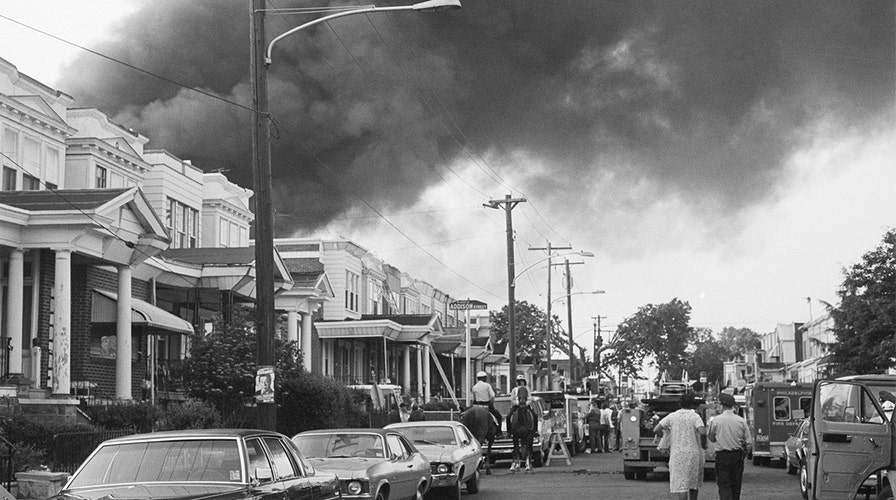Fox News Flash top headlines for April 30
Fox News Flash top headlines are here. Check out what's clicking on Foxnews.com.
Two Ivy League universities have apologized after the remains of a pair of children killed in a 1985 bombing in Philadelphia were kept by researchers for decades without the knowledge of the families.
The MOVE bombing, conducted by city police, killed six adults and five children linked to a Black anarcho-primitivist militant group. And it sparked an inferno that incinerated more than 60 nearby homes.
The remains of two of the children, 14-year-old Tree and 13-year-old Delisha Africa, were believed to have been buried in 1985, according to a petition from surviving MOVE members, who all use Africa as their last name.
PHILADELPHIA EX-MAYOR CALLS FOR CITY APOLOGY IN 1985 BOMBING THAT KILLED 11
"The MOVE Family has been ceaselessly brutalized, criminalized, and dehumanized by the Philadelphia Police Department, held as political prisoners, and murdered," Mike Africa Jr. wrote in a petition demanding the return of the children’s remains. "Now we see clearly that the University of Pennsylvania and Princeton University have perpetuated this racist violence by defiling the remains of our children in the name of research."

Smoke billows over rowhouses in the West Philadelphia after the police bombed the home of the radical African American organization MOVE during a standoff. Police on horseback and emergency vehicles block off a street as residents walk towards the scene. (Getty Images)
Alan Mann, a professor emeritus at both UPenn and Princeton, agreed to turn over the bones to a Philadelphia funeral home Friday morning, according to the Philadelphia Tribune. He had been one of the UPenn anthropology researchers asked to help identify the bones back in the 1980s.
UPenn and Princeton allegedly transferred the girls’ remains back and forth for years for research projects, but the universities’ possession of the bones came to light only last week when it was revealed that they were used in a case study for an online class amid the coronavirus pandemic.
The MOVE scandal comes as both schools have been campaigning for social justice issues – with Princeton stripping former President Woodrow Wilson’s name from its campus over his "racist thinking," and UPenn pledging to return the remains of a different set of Black Philadelphians whose skulls had been used in research supporting White supremacy in the 1800s.

The three blocks on either side of Osage Street in Philadelphia were burnt to the ground as a result of a shootout and bombing during a police confrontation with MOVE in 1985. (Getty Images)
In its petition, MOVE demanded the immediate return of the girls’ remains, formal apologies from both schools, the Penn Museum and Coursera, financial reparations, the removal of all online content related to the bones and the firing of Penn Museum curator Janet Monge, who designed the Coursera class. The online course has also been suspended.
A spokesperson for Princeton said the school’s Department of Anthropology issued an apology Sunday and pointed to a statement from Christopher Eisgruber, the university president, who authorized an outside counsel investigation into the matter.
"I was deeply troubled, as many others have been, by the questions that came to light this past week surrounding the treatment of the remains of a victim of the 1985 bombing of the MOVE house in Philadelphia," he wrote. "I am especially concerned that the remains were used for instruction on our campus, including in a publicly available online course created at Princeton for the Coursera platform and taught by a visiting lecturer from the University of Pennsylvania."

Several Philadelphia police officers patrol the West Philadelphia neighborhood destroyed by the bombing of the MOVE headquarters in 1985. (Getty Images)
A spokesperson for the University of Pennsylvania Museum of Archaeology and Anthropology said officials there were working to return the remains to MOVE and that Director Chris Woods, who assumed the role just a few weeks ago, had reached out directly to the Africa family.
The university and the museum both apologized to the family earlier this week.
Members of MOVE rejected those apologies earlier this week, claiming they were 36 years too late, according to Fox 29 Philadelphia.
MOVE moved into a middle-class Osage Avenue home in West Philadelphia in 1981, three years after a shootout at its previous compound left one police officer dead and sent nine of its members to prison.
The group built its new home into a fortress, drawing the ire of neighbors who complained of trash left outside that attracted rats and other vermin. Members were also known to blast obscene political messages over loudspeakers.
After receiving years of complaints, Philadelphia police decided to act in May 1985. They evacuated neighbors and obtained arrest and search warrants.
MOVE members refused to grant police entry -- resulting in an armed standoff.
Police flew a helicopter overhead and dropped explosives onto a rooftop bunker. The resulting fire wiped out two residential blocks, and when the evacuated residents returned they found only rubble.
CLICK HERE TO GET THE FOX NEWS APP
Then-Fire Commissioner William Richmond said in 2010 that officials were afraid firefighters might be shot at if they tried to extinguish the raging flames. One of the MOVE survivors, Ramona Africa, claimed that it was police who opened fire on survivors trying to flee the burning building.
"The event will remain on my conscience for the rest of my life," then-Mayor W. Wilson Goode wrote in an op-ed for the Guardian last year. "Although I was not personally involved in all the decisions that resulted in 11 deaths, I was chief executive of the city."
The Associated Press contributed to this report.


